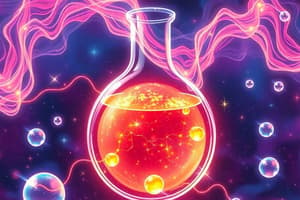Podcast
Questions and Answers
Which state of matter has a definite shape and volume?
Which state of matter has a definite shape and volume?
- Liquid
- Gas
- Solid (correct)
- Plasma
What type of bond is formed by the transfer of electrons?
What type of bond is formed by the transfer of electrons?
- Metallic Bond
- Ionic Bond (correct)
- Covalent Bond
- Hydrogen Bond
Which of the following substances would have a pH greater than 7?
Which of the following substances would have a pH greater than 7?
- Vinegar
- Bleach (correct)
- Battery Acid
- Lemon Juice
What is the mass of one mole of a substance measured in?
What is the mass of one mole of a substance measured in?
In a chemical reaction, what are the starting substances called?
In a chemical reaction, what are the starting substances called?
What do exothermic reactions do?
What do exothermic reactions do?
Which of the following best describes an element?
Which of the following best describes an element?
Which of the following classifications includes metals, nonmetals, and metalloids?
Which of the following classifications includes metals, nonmetals, and metalloids?
Flashcards are hidden until you start studying
Study Notes
Basic Concepts of Chemistry
- Matter: Anything that has mass and occupies space.
- Atoms: The smallest unit of an element, composed of protons, neutrons, and electrons.
- Elements: Pure substances that cannot be broken down. Each element has a unique atomic number.
- Compounds: Substances formed when two or more elements chemically bond together.
States of Matter
- Solid:
- Definite shape and volume
- Particles are closely packed and vibrate in place
- Liquid:
- Definite volume but no definite shape
- Particles are close together but can flow past one another
- Gas:
- No definite shape or volume
- Particles are far apart and move freely
Chemical Bonds
- Ionic Bonds: Formed through the transfer of electrons between atoms, resulting in charged ions.
- Covalent Bonds: Formed when atoms share electrons.
- Metallic Bonds: Involve a 'sea' of shared electrons among a lattice of metal atoms.
Chemical Reactions
- Reactants: Substances that start a reaction.
- Products: Substances formed as a result of a chemical reaction.
- Types of Reactions:
- Synthesis: Two or more substances combine to form one compound.
- Decomposition: A compound breaks down into simpler substances.
- Single Replacement: An element replaces another element in a compound.
- Double Replacement: The exchange of ions between two compounds.
The Mole Concept
- Mole: A unit used to measure the amount of substance, equivalent to Avogadro's number (6.022 x 10²³ particles).
- Molar Mass: The mass of one mole of a substance, usually expressed in grams per mole.
pH and Acids/Bases
- pH Scale: Measures the acidity or alkalinity of a solution, ranging from 0 (acidic) to 14 (basic), with 7 being neutral.
- Acids: Substances that increase the concentration of hydrogen ions (H⁺) in a solution.
- Bases: Substances that increase the concentration of hydroxide ions (OH⁻) in a solution.
Thermodynamics in Chemistry
- Endothermic Reactions: Absorb energy from their surroundings.
- Exothermic Reactions: Release energy into their surroundings.
Periodic Table Overview
- Groups: Vertical columns in the periodic table, indicating elements with similar properties.
- Periods: Horizontal rows, corresponding to the number of electron shells.
- Metals, Nonmetals, Metalloids: Classification based on physical and chemical properties.
Key Chemical Laws
- Law of Conservation of Mass: Mass is neither created nor destroyed in a chemical reaction.
- Law of Definite Proportions: A chemical compound always contains its component elements in fixed ratio by mass.
Organic Chemistry Fundamentals
- Hydrocarbons: Compounds made only of carbon and hydrogen.
- Functional Groups: Specific groups of atoms that influence the characteristics of organic compounds (e.g., alcohols, carboxylic acids).
Common Laboratory Techniques
- Filtration: Separating solids from liquids.
- Distillation: Separating components based on boiling points.
- Titration: Determining the concentration of a solution by reacting it with a solution of known concentration.
Basic Concepts of Chemistry
- Matter: Anything that has mass and occupies space.
- Atoms: The smallest unit of an element, composed of protons, neutrons, and electrons.
- Elements: Pure substances that cannot be broken down, each possessing a unique atomic number.
- Compounds: Formed when two or more elements chemically bond together.
States of Matter
- Solid: Definite shape and volume, particles closely packed and vibrating.
- Liquid: Definite volume but no definite shape, particles closely packed but flowing.
- Gas: No definite shape or volume, particles far apart and moving freely.
Chemical Bonds
- Ionic Bonds: Formed through the transfer of electrons between atoms, resulting in charged ions.
- Covalent Bonds: Formed when atoms share electrons.
- Metallic Bonds: Involve a 'sea' of shared electrons among a lattice of metal atoms.
Chemical Reactions
- Reactants: Substances that start a reaction.
- Products: Substances formed as a result of a chemical reaction.
- Types of Reactions:
- Synthesis: Two or more substances combine to form one compound.
- Decomposition: A compound breaks down into simpler substances.
- Single Replacement: An element replaces another element in a compound.
- Double Replacement: The exchange of ions between two compounds.
The Mole Concept
- Mole: A unit measuring the amount of substance, equivalent to Avogadro's number (6.022 x 10²³ particles).
- Molar Mass: The mass of one mole of a substance, typically in grams per mole.
pH and Acids/Bases
- pH Scale: Measures solution acidity or alkalinity, ranging from 0 (acidic) to 14 (basic), with 7 being neutral.
- Acids: Increase the concentration of hydrogen ions (H⁺) in a solution.
- Bases: Increase the concentration of hydroxide ions (OH⁻) in a solution.
Thermodynamics in Chemistry
- Endothermic Reactions: Absorb energy from their surroundings.
- Exothermic Reactions: Release energy into their surroundings.
Periodic Table Overview
- Groups: Vertical columns in the periodic table, indicating elements with similar properties.
- Periods: Horizontal rows, corresponding to the number of electron shells.
- Metals, Nonmetals, Metalloids: Classification based on physical and chemical properties.
Key Chemical Laws
- Law of Conservation of Mass: Mass is neither created nor destroyed in a chemical reaction.
- Law of Definite Proportions: A chemical compound always contains its component elements in a fixed ratio by mass.
Organic Chemistry Fundamentals
- Hydrocarbons: Compounds made only of carbon and hydrogen.
- Functional Groups: Specific groups of atoms that influence the characteristics of organic compounds (e.g., alcohols, carboxylic acids).
Common Laboratory Techniques
- Filtration: Separating solids from liquids.
- Distillation: Separating components based on boiling points.
- Titration: Determining the concentration of a solution by reacting it with a solution of known concentration.
Studying That Suits You
Use AI to generate personalized quizzes and flashcards to suit your learning preferences.




